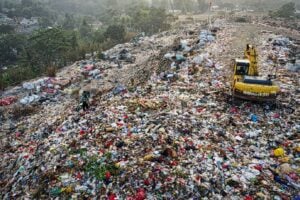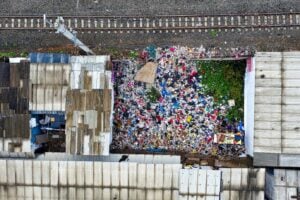July 17, 2022 / by FMP
Filed Under: Uncategorized
 The future of the landfill site: As we continue producing waste, it’s essential to consider! One option is to dump all of it in the landfill. But is that really the best solution?
The future of the landfill site: As we continue producing waste, it’s essential to consider! One option is to dump all of it in the landfill. But is that really the best solution?
Most garbage dumps are just big holes in the ground where we throw our waste and hope it will decompose. But garbage doesn’t decompose quickly, especially if it’s things like plastic or metal. And even when garbage decomposes, it produces methane gas, a greenhouse gas that contributes to climate change.
Swapping seasonal clothes, updating electronics, and eating out contribute to the landfill problem. The average person produces about five pounds of garbage a day. In the United States, we have about two thousand active garbage dumps, which are quickly filling up.
For all these reasons, many people are opposed to landfilling and are looking for alternative waste disposal methods.
Converting a Landfill Site into a Solar Farm
The waste we produce has immense energy potential. Unfortunately, since we leave it to decompose without extracting this energy, it goes to waste—literally.
But what if we could harness the power of garbage? What if, instead of leaving it to decompose and release methane gas into the atmosphere, we could convert it into a renewable energy source?
It is where the idea of solar garbage dumps comes in.
There are more than 10,000 closed and inactive landfills in the United States. These locations provide an outstanding opportunity for solar development because of the undisturbed sun exposure they get. The capped landfill sites are also large, flat areas perfect for solar panels.
In addition to generating renewable energy, solar garbage dumps can create jobs and help the economy. Solar farms require workers for installation, maintenance, and repair. They also need security guards.
The once-garbage-filled sites can be turned into community hubs that provide employment and power to the surrounding area.
Sort and Repurpose Landfill Sites:
There were approximately 6,300 landfill sites in 1990. According to the EPA, this number was reduced to only 1,956 landfill locations in 2014. So, is it safe to say that landfill sites are slowly becoming a thing of the past?
The EPA has also said that 75% of the solid waste sent to landfill sites could be repurposed. It is a considerable number, and it’s one that we should pay attention to.
Waste disposal companies can’t solely depend on landfill sites to generate business anymore. They need to add garbage sorting to their repertoire to stay afloat.
The garbage sorting process begins at the landfill site. Workers sort through the garbage and pull out anything that can be recycled or reused. The sorted waste is then sent to the appropriate location for recycling or repurposing. For instance, broken glass pieces would be sent to a glass recycling plant.
This process not only cuts down on the garbage sent to landfill sites but also helps preserve our natural resources. And it’s good for the economy—sorting and repurposing garbage creates jobs.
Future Landfill Waste to Digestible Products:
We know (and are on terms with) that many items we use daily were once garbage. From paper to plastic!
It is a cycle that we have learned to live with. But how does the idea of digestible products sound? Weird, right?
But a landfill site has the potential to do just that—turn garbage into digestible products.
The process is called anaerobic digestion, which involves breaking down organic matter without oxygen. This process creates biogas, a renewable energy source that can be used as a fertilizer.
In other words, anaerobic digestion can help us to reduce our dependence on fossil fuels and chemicals while also allowing us to fertilize our crops. It’s a win-win
Moreover, if a landfill site has waste like fish guts or manure, the anaerobic digestion process can create a “digestible product” that can be used as animal feed. Think of cod guts being turned into food for chickens. It’s a fascinating process and one that could have a significant impact on the future of landfill sites
 Moving Toward Zero Waste:
Moving Toward Zero Waste:
Ozone depletion, water pollution, and climate change are some environmental issues we face today. And it’s our waste that’s partly to blame.
Luckily, with time, we are becoming more aware of the environmental damage our human activities have on the planet. Whether it’s the carbon emission from our cars or the garbage we produce, it all takes a toll. Hence, we are moving toward a “zero waste” lifestyle.
The term “zero waste” means precisely that—producing no waste. Or, in other words, using all resources efficiently so that there is nothing left to dispose.
There are many ways to reduce waste. For example, we can compost our food scraps instead of throwing them in the garbage. We can carry reusable bags when we go shopping. We can even make our own cleaning products using ingredients that we already have in our homes.
Every bit helps. And as we continue to adapt to a zero-waste lifestyle, the need for landfill sites will slowly disappear.
We like this blog post: Kathryn Kellogg writes The Beginners Guide To Zero Waste Living on her Zero Waste Blog. A great place to start your Zero Waste Journey. We recently wrote a blog about Thrift Shopping to save the planet, please read it!
Final Thoughts on the future of landfill sites:
Waste disposal companies need to adapt or die. That’s the harsh reality of our changing world.
Landfill sites are slowly becoming a thing of the past as we move toward a zero-waste lifestyle. But there’s still much that needs to be done. We must continue educating ourselves and others about the importance of reducing waste. We must be more mindful about the products we buy and how we can dispose them off properly.
And even if we continue to ignorantly produce waste, it’s essential to tap the potential of landfill sites by implementing garbage sorting and anaerobic digestion.
What’s better than waste that doesn’t actually go to waste? Nothing! Extract every ounce of usefulness from garbage, and we’ll all be better off. So, let’s do our part to make sure whatever future is left of landfills is a bright one.
